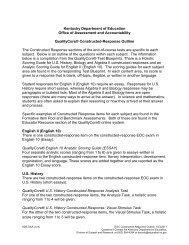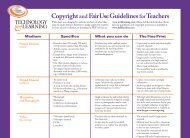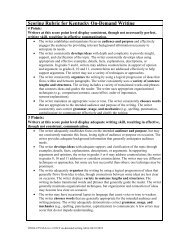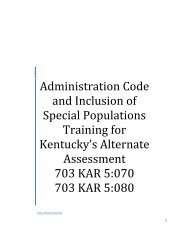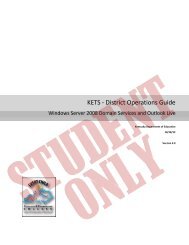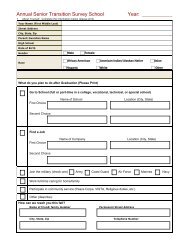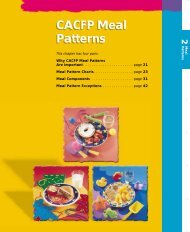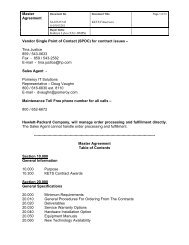Standards with Progressions grades K-HS v. 1.3 - Kentucky ...
Standards with Progressions grades K-HS v. 1.3 - Kentucky ...
Standards with Progressions grades K-HS v. 1.3 - Kentucky ...
- No tags were found...
You also want an ePaper? Increase the reach of your titles
YUMPU automatically turns print PDFs into web optimized ePapers that Google loves.
Number and Operations: Fractions<br />
Grade 3 Grade 4 Grade 5<br />
ote: Grade 3 expectations in this domain<br />
are limited to fractions <strong>with</strong> denominators<br />
2, 3, 4, 6, and 8.<br />
Develop understanding of fractions as<br />
numbers.<br />
3.NF.1: Understand a fraction 1/b as the<br />
quantity formed by 1 part when a whole is<br />
partitioned into b equal parts; understand a<br />
fraction a/b as the quantity formed by a<br />
parts of size 1/b.<br />
3.NF.2: Understand a fraction as a number<br />
on the number line; represent fractions on<br />
a number line diagram.<br />
a. Represent a fraction 1/b on a number line<br />
diagram by defining the interval from 0 to 1<br />
as the whole and partitioning it into b equal<br />
parts. Recognize that each part has size 1/b<br />
and that the endpoint of the part based at 0<br />
locates the number 1/b on the number line.<br />
b. Represent a fraction a/b on a number line<br />
diagram by marking off a lengths 1/b from<br />
0. Recognize that the resulting interval has<br />
size a/b and that its endpoint locates the<br />
number a/b on the number line.<br />
3.NF.3: Explain equivalence of fractions<br />
in special cases, and compare fractions by<br />
reasoning about their size.<br />
a. Understand two fractions as equivalent<br />
(equal) if they are the same size, or the<br />
same point on a number line.<br />
b. Recognize and generate simple<br />
equivalent fractions, e.g., 1/2 = 2/4, 4/6 =<br />
2/3). Explain why the fractions are<br />
equivalent, e.g., by using a visual fraction<br />
model.<br />
c. Express whole numbers as fractions, and<br />
recognize fractions that are equivalent to<br />
whole numbers. Examples: Express 3 in the<br />
form 3 = 3/1; recognize that 6/1 = 6; locate<br />
4/4 and 1 at the same point of a number<br />
line diagram.<br />
d. Compare two fractions <strong>with</strong> the same<br />
numerator or the same denominator by<br />
reasoning about their size. Recognize that<br />
comparisons are valid only when the two<br />
fractions refer to the same whole. Record<br />
the results of comparisons <strong>with</strong> the symbols<br />
>, =, or , =, or 1 as a sum of fractions 1/b.<br />
a. Understand addition and subtraction of fractions as joining and separating parts<br />
referring to the same whole.<br />
b. Decompose a fraction into a sum of fractions <strong>with</strong> the same denominator in more than<br />
one way, recording each decomposition by an equation. Justify decompositions, e.g.,<br />
by using a visual fraction model. Examples: 3/8 = 1/8 + 1/8 + 1/8 ; 3/8 = 1/8 + 2/8 ; 2<br />
1/8 = 1 + 1 + 1/8 = 8/8 + 8/8 + 1/8.<br />
c. Add and subtract mixed numbers <strong>with</strong> like denominators, e.g., by replacing each mixed<br />
number <strong>with</strong> an equivalent fraction, and/or by using properties of operations and the<br />
relationship between addition and subtraction.<br />
d. Solve word problems involving addition and subtraction of fractions referring to the<br />
same whole and having like denominators, e.g., by using visual fraction models and<br />
equations to represent the problem.<br />
Use equivalent fractions as a strategy to add and subtract fractions.<br />
5.NF.1: Add and subtract fractions <strong>with</strong> unlike denominators (including<br />
mixed numbers) by replacing given fractions <strong>with</strong> equivalent<br />
fractions in such a way as to produce an equivalent sum or<br />
difference of fractions <strong>with</strong> like denominators. For example,<br />
2/3 + 5/4 = 8/12 + 15/12 = 23/12. (In general, a/b + c/d = (ad +<br />
bc)/bd.)<br />
5.NF.2: Solve word problems involving addition and subtraction of<br />
fractions referring to the same whole, including cases of unlike<br />
denominators, e.g., by using visual fraction models or equations<br />
to represent the problem. Use benchmark fractions and<br />
number sense of fractions to estimate mentally and assess the<br />
reasonableness of answers. For example, recognize an incorrect<br />
result 2/5 + 1/2 = 3/7, by observing that 3/7 < 1/2.<br />
Apply and extend previous understandings of multiplication and division<br />
to multiply and divide fractions.<br />
5.NF.3: Interpret a fraction as division of the numerator by the<br />
denominator (a/b = a ÷ b). Solve word problems involving<br />
division of whole numbers leading to answers in the form of<br />
fractions or mixed numbers, e.g., by using visual fraction<br />
models or equations to represent the problem. For example,<br />
interpret 3/4 as the result of dividing 3 by 4, noting that 3/4<br />
multiplied by 4 equals 3, and that when 3 wholes are shared<br />
equally among 4 people each person has a share of size 3/4. If 9<br />
people want to share a 50-pound sack of rice equally by weight,<br />
how many pounds of rice should each person get Between<br />
what two whole numbers does your answer lie<br />
5.NF.4: Apply and extend previous understandings of multiplication to<br />
multiply a fraction or whole number by a fraction.<br />
a. Interpret the product (a/b) × q as a parts of a partition of q<br />
into b equal parts; equivalently, as the result of a sequence<br />
of operations a × q ÷ b. For example, use a visual fraction<br />
model to show (2/3) × 4 = 8/3, and create a story context for<br />
this equation. Do the same <strong>with</strong> (2/3) × (4/5) = 8/15. (In<br />
general, (a/b) × (c/d) = ac/bd.)<br />
b. Find the area of a rectangle <strong>with</strong> fractional side lengths by<br />
tiling it <strong>with</strong> unit squares of the appropriate unit fraction<br />
side lengths, and show that the area is the same as would<br />
be found by multiplying the side lengths. Multiply fractional<br />
side lengths to find areas of rectangles, and represent<br />
fraction products as rectangular areas.<br />
<strong>Kentucky</strong> Department of Education<br />
18 | P a g e




